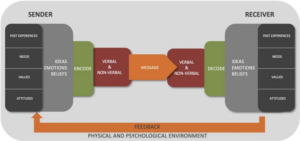
Did you know…there is a subset of people among us, that when they receive a text message or an email with NO emojis, NO exclamation marks – anywhere – they feel the sender is mad at them. You know who you are!! 😊
This is an example of how our personalities affect our communication with others. Whether one is generally more cautious or generally more assertive, or whether one gets their energy from people and relationships vs. data and facts – these things impact how we send and receive messages.
Individuals have fairly predictable needs and behaviors, which create inherent biases in our communication styles.
The Osgood-Schramm model of communication helps us understand that in every interpersonal interaction, there is a process of encoding, decoding and interpreting a message. As the receiver of a message, we process verbal and non-verbal cues from the sender. Then the information passes further into decode-mode, where the message gets filtered through our ideas, emotions, beliefs, needs, values, attitudes and past experiences – a.k.a. “semantic noise”.
If that isn’t enough baggage for you, remember that both the sender and receiver have these unique filters based on their individual personalities. Each one-way message passes through them twice, the sender’s filters and the receiver’s filters. As the dialogue continues, the message gets bounced back and forth through this psychological feedback loop.
That leaves a huge margin for error when it comes to interpreting someone’s words and applying our own biases to assign motive and intent.
Two people that have similar personalities, similar experiences and are both healthy on that particular day, might have more of a fun game of verbal ping pong. They yin and yang and run off into the sunset together collaborating on the day’s splendors.
That leaves a huge margin for error when it comes to interpreting someone’s words and applying our own biases to assign motive and intent.
Two people that have opposing personalities, with very different life experiences, experiencing stress or pressure on that particular day, might feel like they need body armor in this game of paintball.
In our highly hybrid and virtual world, that margin for error can become a canyon for interpersonal conflict and disconnect.
As high-performers transition from being individual contributors, to managers, to leaders, the need to understand psychology and human behavior really becomes critical to success. This is largely overlooked and minimized in cultures that don’t prioritize leadership development. And to be fair, this really impacts everyone at an organization, not just leaders.
For organizations and leaders that want to embrace healthy communication, I recommend the following steps to get started:
1. Promote and encourage self-awareness. It has to start with everyone really knowing themselves, knowing their personality, their style, their preferences, and feeling safe to be themselves. There are a number of tools to help provide objective self-analysis, ask me about this!
2. Seek to understand others. You know the expression, “seek to understand before being understood”. Much easier said than done! But if everyone can commit to this, even 50% of the time, it creates a culture of empathy. An environment where communication can thrive.
3. Commit to meeting in the middle. Take time to learn and adapt the strategies necessary to adjust to other styles. Trust that if you make the effort to meet them in the middle, they will do the same for you.
